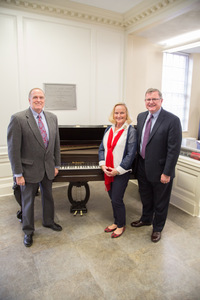

Pictured left to right – King Professor W. Patrick Flannagan, Lee Caldwell Coffman, King President Alexander Whitaker.
BRISTOL, Tenn. – In continued celebration of King University's 150th anniversary of the founding of the institution, King has unveiled a piece of history tied to the university's founder, Rev. James King, and his family. On Monday, Nov. 29, the university revealed a refurbished Knabe square grand piano, also known as a parlor grand, which is now on display in the foyer of the E.W. King Library on the main campus in Bristol, Tenn.
"We are truly thrilled to have Lee Caldwell Coffman, the great-great-great-granddaughter of the Rev. James King, to help us unveil this magnificently restored instrument which belonged to her family," said King President Alexander Whitaker. "It is in our nature to connect through artifacts. This piano connects us to our history – to our story. One of the things I want to do as president is to rekindle that sense of story. This piano is a wonderful, visible reminder of that connection to a family who was critically important to the beginning and sustaining of this school."
"Originally, donated to King by Miss Reveley Owen, a great-granddaughter of the Rev. James King, the piano did not have an adequate home on the campus for many years until today," said Denise Asbury, director of development. "The outer casing has been refurbished to its original grandeur and is displayed in the lobby of the E.W. King Library as a tribute to the Rev. King's generosity and the King family legacy."
The piano was constructed by Wm. Knabe & Co. of Baltimore, Md. Respected for nearly 200 years, the company became a part of American history when in 1838, Francis Scott Key commissioned the company to custom-build a square grand piano for his home. In 1926, the company was chosen as the official piano of the Metropolitan Opera in New York City, N.Y. Today, Knabe is the premium piano for Samick Music Corporation, one of the world's largest musical instrument manufacturers. The company continues the tradition of creating handmade, limited production pianos, which are renowned for their rich and wondrous tonal quality producing a sound described as the nearest approach to the human singing voice.